 W
WPhilips van der Aa was a politician in the Seventeen Provinces and a statesman of the Dutch Republic during its struggle for independence, the Eighty Years' War.
 W
WBaron Francis van Aarssens or Baron François van Aerssen, from 1611 on lord of Sommelsdijk, was a diplomat and statesman of the United Provinces.
 W
WAdolf of Nassau was a count of Nassau, also known as Adolphus of Nassau. He was the fourth son and sixth child of William I, Count of Nassau-Dillenburg and Juliana of Stolberg. He was the second youngest brother of William the Silent.
 W
WLaurens Jacobsz Alteras was a 17th-century Dutch vice admiral who distinguished himself as fleet commander under Jacob van Heemskerck in the battle of Gibraltar of 1607.
 W
WA Dutch skipper from Leur, Adriaen van Bergen devised the plot to recapture the city of Breda from the Spanish during the Eighty Years' War. In February 1590, he approached Prince Maurice with a Trojan horse type plan.
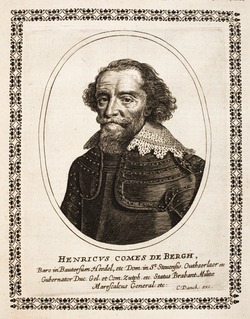 W
WHendrik Graaf van den Bergh, lord of Stevensweert, was a Dutch soldier in Spanish service during the Eighty Years' War and stadhouder of Spanish Upper Guelders.
 W
WAdriaan Teding van Berkhout was an eminent Dutch jurist, justice in the Hof van Holland, and politician of the Dutch Republic. He was a friend of Johan van Oldenbarnevelt, who tried to warn the latter of his impending arrest before the Trial of Oldenbarnevelt, Grotius and Hogerbeets.
 W
WWillem Bloys van Treslong was a nobleman from the Southern Netherlands and military leader during the Dutch war of Independence. He was best known as one of the leaders of the Sea Beggars who captured Den Briel on 1 April 1572.
 W
WLancelot van Brederode was a Dutch general in the Dutch Revolt. He was vice admiral of the 'geuzen' or 'Sea Beggars' and a captain in the army of Louis of Nassau.
 W
WReinoud van Brederode was a Dutch nobleman, lawyer and diplomat of the Dutch Golden Age. He was lord of Veenhuizen, Spanbroek, Oosthuizen, Etersheim, Hobrede and Kwadijk.
 W
WPaulus van Caerden was a Dutch admiral in service of the Dutch East India Company. He was governor of the Maluku Islands for one month.
 W
WJan van Casembroot, Lord of Backerzele was a Flemish noble and poet. He was lord of Bekkerzeel, Zellik, Kobbegem, Berchem and Fenain.
 W
WDirck Volckertszoon Coornhert, also known as Theodore Cornhert, was a Dutch writer, philosopher, translator, politician, theologian and artist. Coornhert is often considered the Father of Dutch Renaissance scholarship.
 W
WMargaretha Coppier or Margaretha van Kalslagen was a Dutch noble and a heroine of the Dutch war of liberation.
 W
WJanus Dousa, Lord of Noordwyck, was a Dutch statesman, jurist, historian, poet and philologist, and the first Librarian of Leiden University Library.
 W
WLamoral, Count of Egmont, Prince of Gavere was a general and statesman in the Spanish Netherlands just before the start of the Eighty Years' War, whose execution helped spark the national uprising that eventually led to the independence of the Netherlands.
 W
WPhilip, Count of Egmont was the fifth Count of Egmont, prince of Gavere and 12th and last Lord of Purmerend, Purmerland and Ilpendam.
 W
WFrederick Henry was the sovereign prince of Orange and stadtholder of Holland, Zeeland, Utrecht, Guelders, Overijssel in the Dutch Republic from 1625 until his death in 1647. The last seven years of his life he also was the stadtholder of Groningen (1640-1647).
 W
WLenaert Jansz de Graeff was a member of the family De Graeff and the son of Jan Pietersz Graeff, a rich cloth merchant from Amsterdam. Lenaert Jansz de Graeff was one of the leaders of the Protestant Reformation at Amsterdam, friend of Henry, Count of Bréderode, the "Grote Geus", and perhaps ident with "Monseigneur de Graeff", a captain of the Sea Beggars during the Capture of Brielle.
 W
WFranciscus Haraeus, , was a theologian, historian, and cartographer from the Low Countries. He is best known for his history of the origins of the Dutch Revolt, written from a Catholic perspective but without polemical bias. He was one of the first cartographers to make thematic maps and globes.
 W
WKenau Simonsdochter Hasselaer (1526–1588) was a wood merchant of Haarlem, who became a legendary folk hero for her fearless defense of the city against the Spanish invaders during the siege of Haarlem in 1573.
 W
WPieter Dircksz. Hasselaar was an Amsterdam brewer and schepen (alderman), and one of the founders of the Dutch East India Company. He is famous, along with his aunt Kenau Simonsdochter Hasselaer, for courageous actions during the siege of Haarlem in 1573. In 1578, after the Alteratie, he moved to Amsterdam and by 1583 was manager of the brewery of Andries Boelens. In 1587 he bought a brewery, the Eagle, between Nieuwendijk and Prins Hendrikkade.
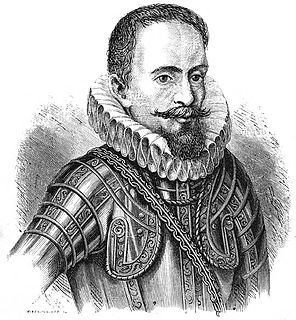 W
WJacob van Heemskerck was a Dutch explorer and admiral.
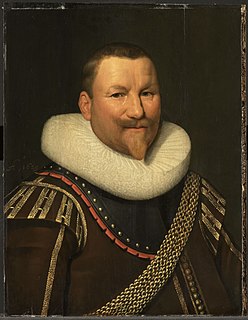 W
WPiet Pieterszoon Hein was a Dutch admiral and privateer for the Dutch Republic during the Eighty Years' War. Hein was the first and the last to capture a large part of a Spanish treasure fleet which transported huge amounts of gold and silver from Spanish America to Spain. The amount of silver taken was so big that it resulted in the rise of the price of silver worldwide and the near bankruptcy of Spain.
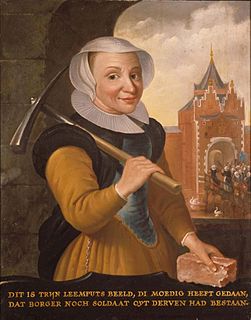 W
WTrijn van Leemput was a Dutch heroine of the Eighty Years' War against Spain. According to local legend in Utrecht, she led a large group of women on May 2, 1577, to the castle of Vredenburg and gave the signal to begin demolishing the castle.
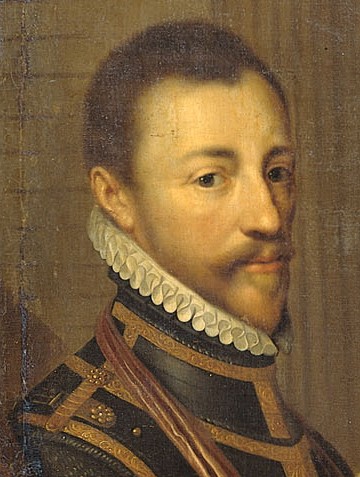 W
WLouis of Nassau was the third son of William, Count of Nassau and Juliana of Stolberg, and the younger brother of Prince William of Orange Nassau.
 W
WWilliam II de la Marck was the Dutch Lord of Lumey and initially admiral of the Watergeuzen, the so-called 'sea beggars' who fought in the Eighty Years' War (1568–1648), together with among others William the Silent, Prince of Orange-Nassau. He was the great-grandson of an equally notorious character, baron William de la Marck, nicknamed the "wild boar of the Ardennes".
 W
WPhilips of Marnix, Lord of Saint-Aldegonde, Lord of West-Souburg was a Flemish and Dutch writer and statesman, and the probable author of the text of the Dutch national anthem, the Wilhelmus.
 W
WMaurice of Orange was stadtholder of all the provinces of the Dutch Republic except for Friesland from 1585 at the earliest until his death in 1625. Before he became Prince of Orange upon the death of his eldest half-brother Philip William in 1618, he was known as Maurice of Nassau.
 W
WCornelis van der Mijle was a Dutch politician and diplomat in the service of the Dutch Republic and a regent of Leiden University. He was the son-in-law of Johan van Oldenbarnevelt.
 W
WJoos de Moor was a Dutch Vice Admiral of Zeeland from the 16th century. In 1603 in the Battle of Sluis he defeated a Spanish fleet under Admiral Federico Spinola. He was the son of Jan de Moor, first vice-admiral of Zeeland. He was married to Dina Crins, Janneken Ingels, and Catarina Struvingts. He died at Vlissingen and is buried in the St James the Great Church.
 W
WJohn VIII, Count of Nassau-Siegen was a German nobleman and militarist of the 17th century.
 W
WAmalia of Neuenahr was the daughter of Gumprecht of Neuenahr and Cordula of Holstein Schauenburg.
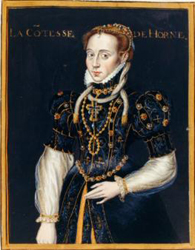 W
WAnna Walburgis van Nieuwenaer (1522-1600) was a politically active Dutch countess.
 W
WOlivier van Noort was a Dutch merchant captain and pirate and the first Dutchman to circumnavigate the world.
 W
WJohan van Oldenbarnevelt, Heer van Berkel en Rodenrijs (1600), Gunterstein (1611) and Bakkum (1613) was a Dutch statesman who played an important role in the Dutch struggle for independence from Spain.
 W
WAdriaan Pauw, knight, heer van Heemstede, Bennebroek, Nieuwerkerk etc. was Grand Pensionary of Holland from 1631 to 1636 and from 1651 to 1653.
 W
WPhilip of Nassau or Filips of Nassau was a Count of Nassau, Katzenelnbogen, Vianden and Dietz, fought for the United Provinces during the Eighty Years' War. He was the son of John VI and Countess Elisabeth of Leuchtenberg.
 W
WWigbolt, Baron Ripperda was the city governor of Haarlem when the city was under siege by the Spanish army in the Eighty Years' War.
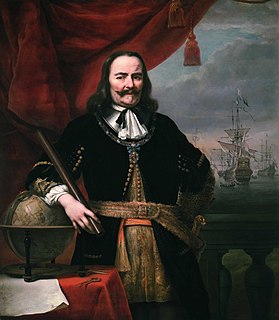 W
WMichiel Adriaenszoon de Ruyter was a Dutch admiral. Widely celebrated and regarded as one of the most skilled admirals in history, De Ruyter is arguably most famous for his achievements with the Dutch Navy during the Anglo-Dutch Wars. He fought the English and French forces and scored several critical victories, with the Raid on the Medway being the most famous among them.
 W
WMaria van Schooten (1555–1573) was a Dutch heroine from the Eighty Years' War. She died from the injuries she received after having participated in the defense during the Siege of Haarlem and was given a public funeral with full military honors. She is believed to have been one of the women led by Kenau Simonsdochter Hasselaer, a legendary heroine who helped defend Haarlem against the Spanish invaders.
 W
WJoost de Soete or de Zoete, Lord of Villers or Villiers, was a Dutch nobleman and Field Marshal who fought in the early years of the Eighty Years' War.
 W
WDiederik Sonoy or Snoey was a leader of the Geuzen during the Eighty Years' War.
 W
WJoris van Spilbergen was a Dutch naval officer. Joris van Spilbergen was born in Antwerp in 1568.
 W
WJochem Hendrickszoon Swartenhont was a Dutch naval officer in the navy of the Dutch Republic from the 17th century.
 W
WMaarten Harpertszoon Tromp was a Dutch army general and admiral in the Dutch navy.
 W
WCornelis van Aerssen was a statesman in Holland.
 W
WMaarten Gerritszoon Vries, or Fries, also referred to as de Vries, was a 17th-century Dutch cartographer and explorer, the first Western European to leave an account of his visit to Ezo, Sakhalin, Kuril Islands and the Sea of Okhotsk.
 W
WWilliam Louis of Nassau-Dillenburg was Count of Nassau-Dillenburg from 1606 to 1620, and stadtholder of Friesland, Groningen, and Drenthe.
 W
WWitte Corneliszoon de With was a Dutch naval officer. He is noted for planning and participating in a number of naval battles during the Eighty Years War and the First Anglo-Dutch war.
 W
WWillem van der Zaan was a Dutch Admiral. His name is often given in the 17th century spelling Zaen.